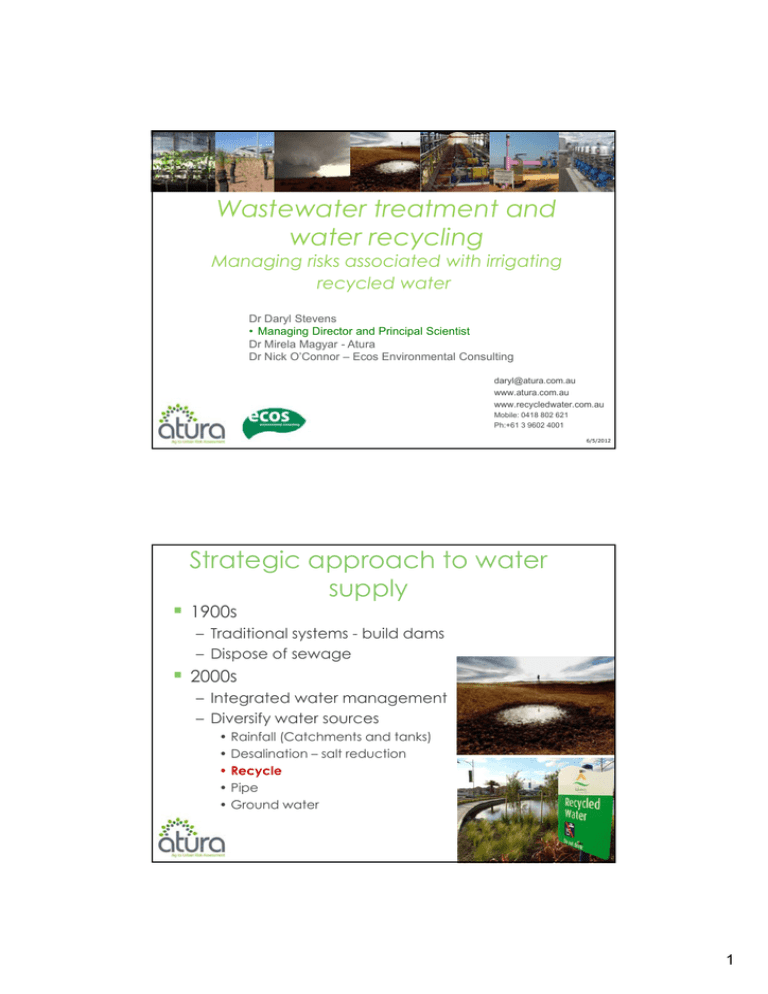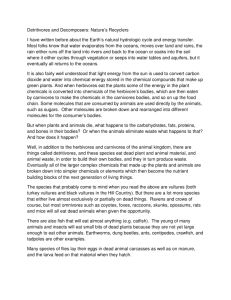Wastewater treatment and water recycling Strategic approach to water supply
advertisement

Wastewater treatment and water recycling Managing risks associated with irrigating recycled water Dr Daryl Stevens • Managing Director and Principal Scientist Dr Mirela Magyar - Atura Dr Nick O’Connor – Ecos Environmental Consulting daryl@atura.com.au www.atura.com.au www.recycledwater.com.au Mobile: 0418 802 621 Ph:+61 3 9602 4001 6/5/2012 Strategic approach to water supply 1900s – Traditional systems - build dams – Dispose of sewage 2000s – Integrated water management – Diversify water sources • Rainfall (Catchments and tanks) • Desalination – salt reduction • Recycle • Pipe • Ground water 6/5/2012 1 Water management Sources Desalination (Seawater) Rainfall (ground water, dams and tanks) Recycling (direct, indirect, drinkable) What do Astronauts do? Source management Demand management Interconnection between sources Water trading Storage and recovery Increasing efficiencies Department of Water Resources, SA 6/5/2012 Australian water reuse Major water recyclers – Agriculture – Other Industries – Water supply Total Reuse is – 15% of Urban Water – 5% of Agricultural water 2 What makes up sewage? Water Inorganic chemicals Organic chemicals Pathogens Microbes Organic matter Minerals Suspended materials Physical properties (e.g. temperature) 6/5/2012 Raw sewage pathogens Typically Viruses – e.g. Rotavirus: 8,000/L (actually Adenoviruses!) Protozoa or parasites – e.g. Cryptosporidium: 2,000/L (may not be viable!) Bacteria – e.g. Campylobacter: 7,000/L (actually, UK data!) – e.g. Helminthes (1-1000/L) – e.g. Taenia, Ascaris 6/5/2012 3 Key environmental hazards Key environmental hazards Additional hazards associated with use for environmental allocation •Boron •Cadmium •Chloride •Chlorine disinfection residuals •Hydraulic loading (water) •Nitrogen •Phosphorus •Salinity •Sodium •Ammonium •Aluminium •Arsenic •Copper •Lead •Mercury •Nickel •Zinc •Phenol •Surfactants ie Linear alkylbenzene sulfonates (LAS) and alcohol ethoxylated surfactants (AE) Hazards – Physical/chemical General – pH, BOD, Temp, Hydraulic load Nutrient – B, N, P, K, Na, S, Cal, Fe, Zn, etc Metals/metaloids/halides – Hg, Pb, F, Zn, CN, etc. Surfactants – AES, LAS and SAS Organic compounds Pesticides and their metabolites Disinfection by-products Radionuclides Pharmaceuticals Algal toxins Estrogenic and androgenic hormones Antiseptics 6/5/2012 4 Overview of what is in sewage EPA Ireland (2007) Waste Water Treatment Manuals. Primary, Secondary and Tertiary Treatment. Ardavan, Wexford, Ireland: Environmental Protection Agency 6/5/2012 Sewage treatment basics 6/5/2012 5 Typical Activated Sludge Treatment Plant 6/5/2012 Typical Physical-Chemical Treatment Plant 6/5/2012 6 Sludge Treatment Includes processes: – Concentration (dewatering, mass reduction), – Stabilization, – Disposal/Benefical use Sludge produced during the primary, secondary and tertiary treatments. Treatment levels 6/5/2012 6/5/2012 7 WWTP: a critical control point Cunningham VL (2008) Environmental Exposure Modeling: Application of PhATETM and Great-ER to Human Pharmaceuticals in the Environment In K. Kümmerer, ed. Pharmaceuticals in the Environment Berlin, Heidelberg: Springer Berlin Heidelberg, p. 133–146 6/5/2012 Overview of STP processes 6/5/2012 8 Overview of biosolids treatment 6/5/2012 Basic principles of AGWR Aim is to ensure (as much as possible) that recycled water is safe before use A coordinated approach from source to point of use Reduces reliance on recycled water testing (too little, too late) 6/5/2012 9 Hydrological cycle Key: Phase 1 Phase 2 6/5/2012 Sewer mining Municipal use 6/5/2012 10 STP and Soil Models 6/5/2012 Modelling degradation through the STP to assess risk 6/5/2012 11 Source Sewers Sewage treatment Environmental compartments Receptor 6/5/2012 Variables: Phyico-chem BTF estimates (measured/predicted) = BCF M:P Biodegradation rates (measured/predicted) = Biodegrade M:P Variation in toxicity impact on population Variation in Henry’s law constant (log10 measured/predicted) = Log HLC M:P Variation in Log Koc = LogKocP-+M Variation in Log Kow = LogKowP-+M as defined by EPI Suite (USEPA, 2011b) 6/5/2012 12 Variables: Soil Irrigation rate = IR Depth of irrigation water = Depth Irrigated PDF Soil bulk density PDF = SoilBD Leaching rates = Leach Root density = Den_roots Fraction of organic carbon in soil = FOC Mass fraction of organic carbon = FOCM 6/5/2012 Input variable STP Typical influent to process step (ML/D) VSS Sludge Conc (g/m3) TSS Sludge Conc (g/m3) Receptor Yield Weight (Child/Adult) Bodyfat Pasture intake Stockwater source and volumes consumed 6/5/2012 13 180 160 140 120 100 80 60 40 20 0 Frequency PDF of child/adult weight 6/5/2012 PDF of water ingested 6/5/2012 14 PDF of soil ingested 6/5/2012 Irrigation requirements 6/5/2012 15 Preventive measures Exclusion barrier – Effective design of WTP – Decrease concentration – Hazard source control – Storage design – System maintenance – Water Treatment End-use Restrictions – – – – – – – Buffer distances/strips Crop/plants grown Hydraulic load Irrigation tools Light reduction Nutrient balancing Shandy with fresh water – Site selection – Soil ameliorant 6/5/2012 Risk Management Systems HACCP - Food & beverage safety & quality HAZOP - Plant operation CHAIR - Plant layout/operability, safety AZ/NZS 4360 - Risk management 6/5/2012 16 Benefits of Risk Assessment 6/5/2012 Hazards: SRA General – pH, BOD, Temp, Hydraulic load Nutrient – B, N, P, K, Na, S, Cal, Fe, Zn, etc Metals/metaloids/halides – Hg, Pb, F, Zn, CN, etc. Surfactants – AES, LAS and SAS Organic compounds Pesticides and their metabolites Disinfection by-products Radionuclides Pharmaceuticals Algal toxins Estrogenic and androgenic hormones Antiseptics 6/5/2012 17 Hazard control & preventive measure Within target criteria and critical limit Hazard controlled by • Preventive Preventive measures measures • Critical control Exclusion barrier (prevents entry or removes hazard ) points • Target criteria • Critical limits Within target criteria End-use restriction barrier (controls exposure) Critical limit exceeded Monitoring program Control lost Unacceptable health or environmental risk Deviation from target criteria Take corrective action immediately Losing control Within target criteria Critical Control Point Take corrective action Critical limit exceeded Inform health or environment regulator? 6/5/2012 Hazard quotient PEC PNEC 6/5/2012 18 HQ MRL Plants 6/5/2012 Sensitivity analysis: MRL Plant 6/5/2012 19 Sensitivity analysis: MRL Beef Includes Stockwater 6/5/2012 Sensitivity analysis: MRL Beef No recycled water as Stockwater 6/5/2012 20 Milk MRLs sensitivity to Soil? 6/5/2012 Modelling system sensitivities 6/5/2012 21 Modelling system sensitivities 6/5/2012 Irrigation of plants g 0.79 0.8 5.0% / y 4.12 90.0% 5.0% 0.7 Irrigation water / Hexythiazox 0.5 Minimum Maximum Mean Median Std Dev 10% 90% Values 0.4 0.3 0.790 13.309 1.807 1.480 1.141 0.794 3.088 500 0.2 0.1 14 12 10 8 6 4 2 0.0 0 Frequency 0.6 Variable 6/5/2012 22 300 250 200 150 100 Frequency 50 Values x 10^4 Plant toxicity 6/5/2012 Modelling sensitivities 6/5/2012 23 Half-lives in chemicals potentially in recycled water 6/5/2012 Management Strategies? Enduse Volume of soil and recycled water ingested by cattle Irrigation rates and total loads Soil depth of incorporation Restriction barrier Source control and tradewaste management crucial Sewage treatment plant flow rate Raw suspended solids entering STP Total organic carbon load to STP 6/5/2012 24 Thank you! www.atura.com.au daryl@atura.com.au 6/5/2012 25





